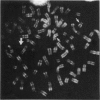Abstract
In mammalian somatic cells, sex-chromosome dosage compensation is achieved by random inactivation of one of the two X chromosomes. The Xg blood group antigen (Xg) and steroid sulfatase (STS) loci on the distal end of the short arm of the X chromosome have been shown to escape this inactivation. However, it has been reported that on structurally abnormal inactive X chromosomes Xg and STS are inactivated. This discrepancy requires further consideration since whatever process accounts for the lack of inactivation of these loci on structurally normal, inactive X chromosomes might be anticipated to be operative on structurally abnormal, inactive X chromosomes. To investigate this issue, we examined the expression of STS activity in mouse-human somatic-cell hybrids retaining two different, deleted, inactive human X chromosomes. These studies provide evidence for lack of inactivation of STS on structurally abnormal, inactive X chromosomes.
Full text
PDF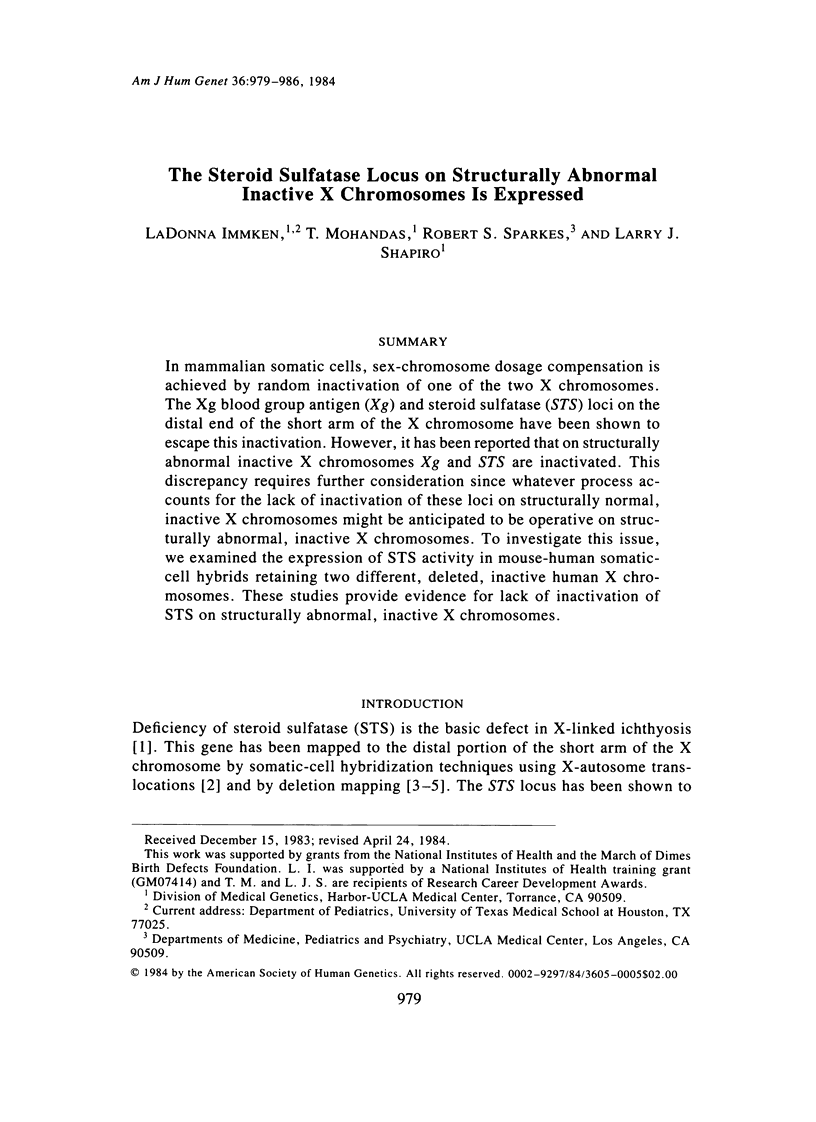
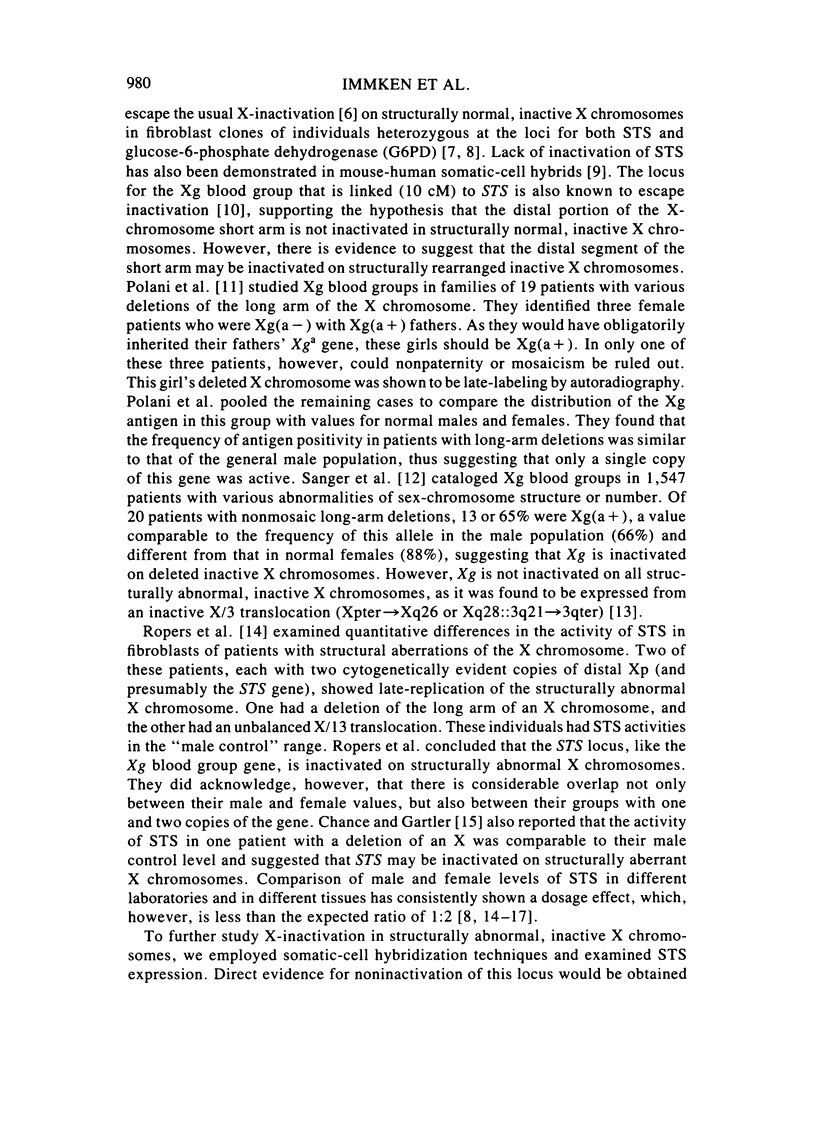

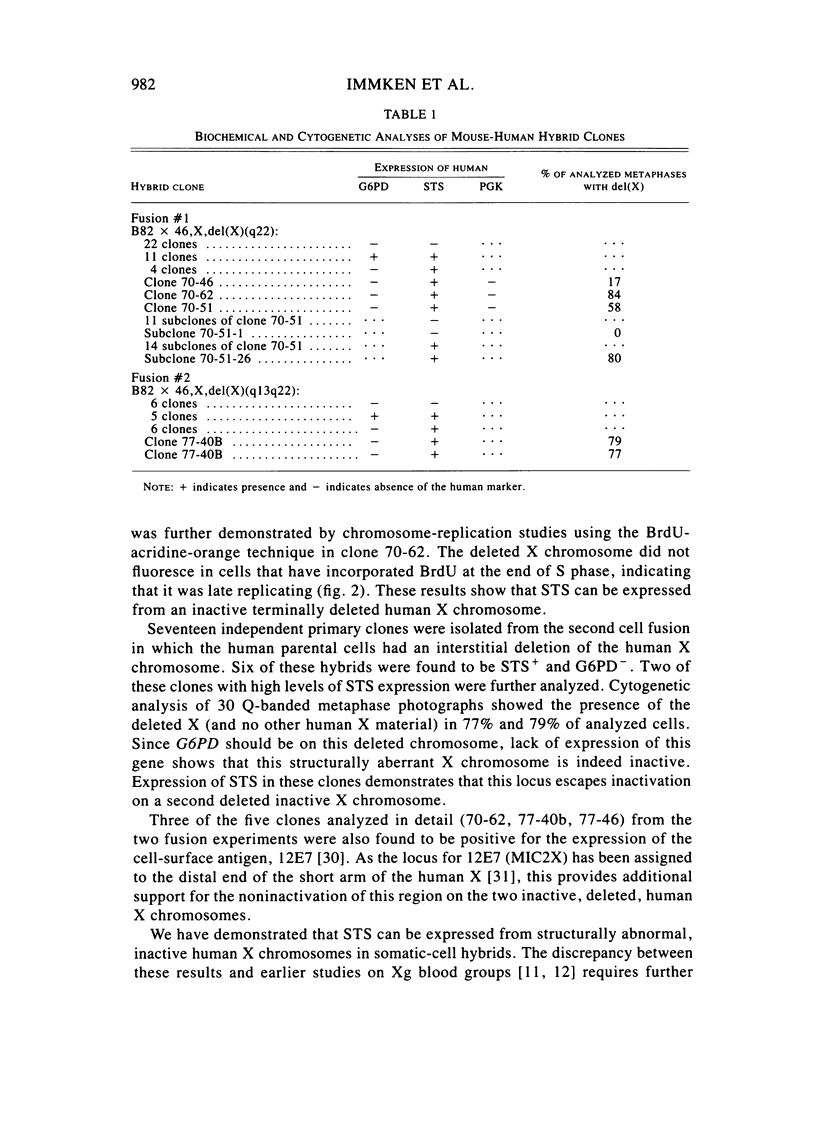
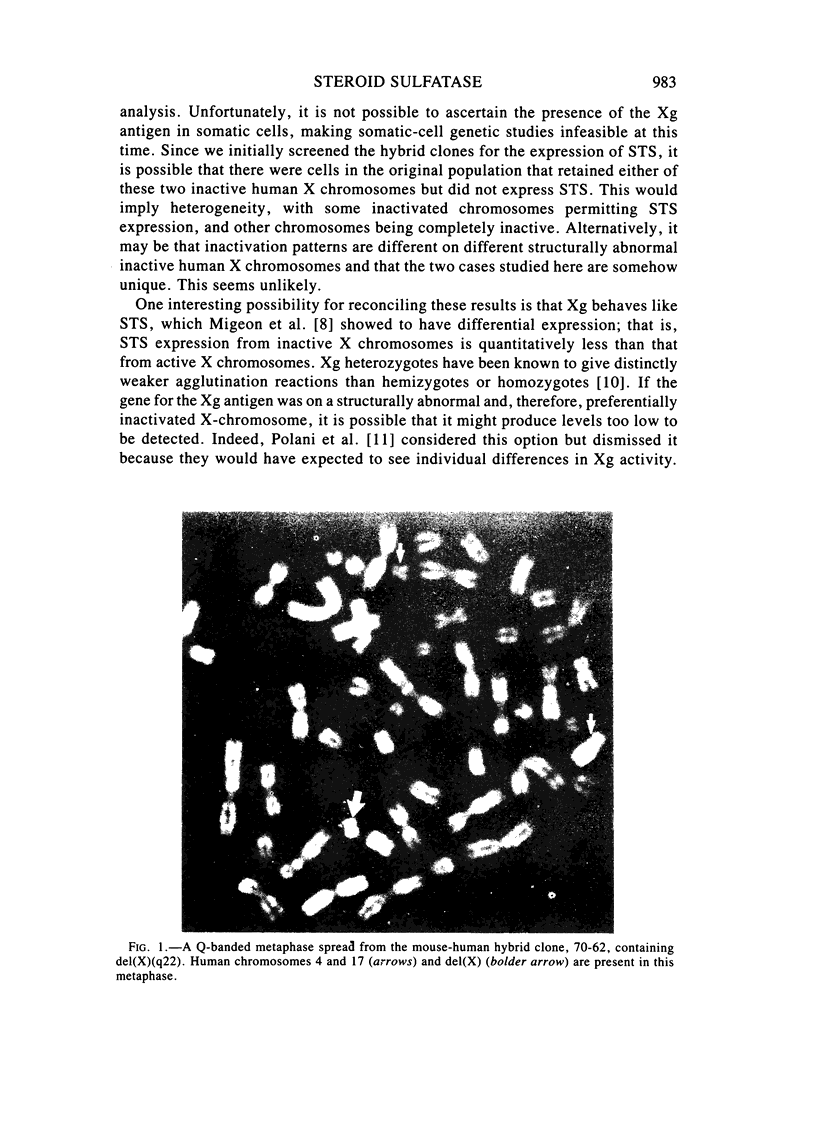
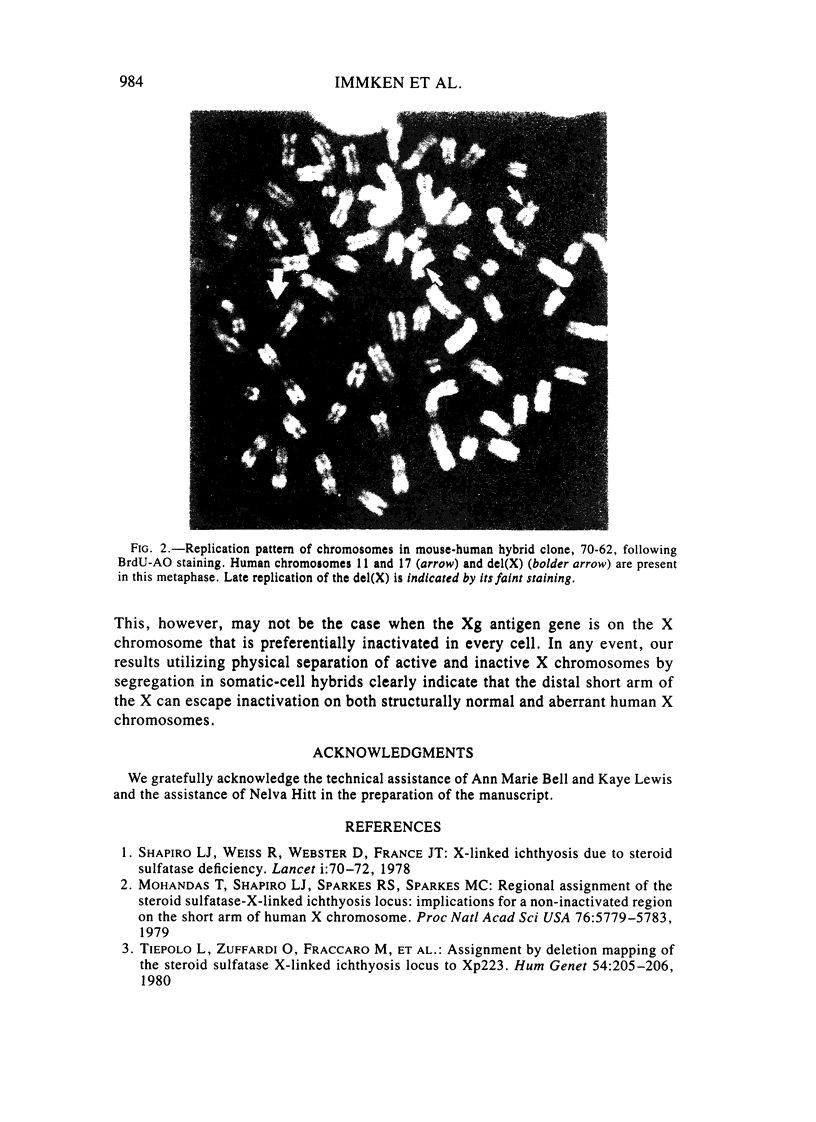
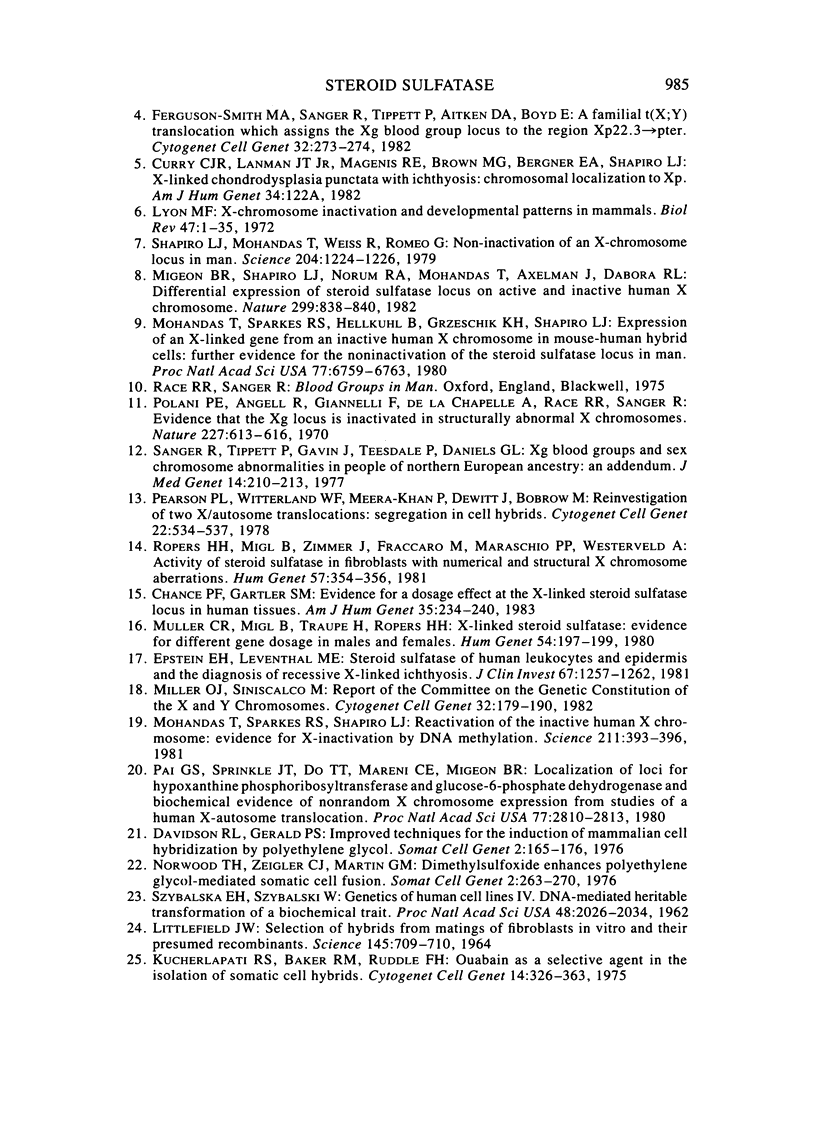
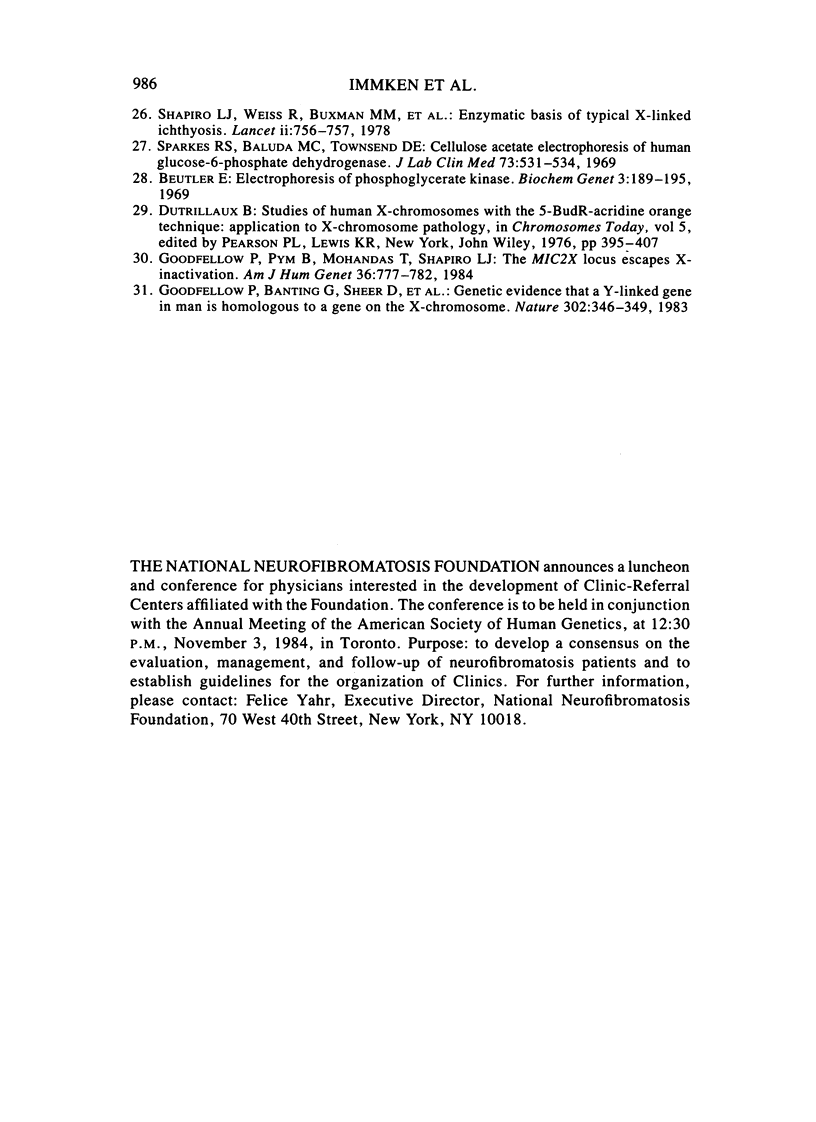
Images in this article
Selected References
These references are in PubMed. This may not be the complete list of references from this article.
- Beutler E. Electrophoresis of phosphoglycerate kinase. Biochem Genet. 1969 Apr;3(2):189–195. doi: 10.1007/BF00520353. [DOI] [PubMed] [Google Scholar]
- Chance P. F., Gartler S. M. Evidence for a dosage effect at the X-linked steroid sulfatase locus in human tissues. Am J Hum Genet. 1983 Mar;35(2):234–240. [PMC free article] [PubMed] [Google Scholar]
- Davidson R. L., Gerald P. S. Improved techniques for the induction of mammalian cell hybridization by polyethylene glycol. Somatic Cell Genet. 1976 Mar;2(2):165–176. doi: 10.1007/BF01542629. [DOI] [PubMed] [Google Scholar]
- Epstein E. H., Jr, Leventhal M. E. Steroid sulfatase of human leukocytes and epidermis and the diagnosis of recessive X-linked ichthyosis. J Clin Invest. 1981 May;67(5):1257–1262. doi: 10.1172/JCI110153. [DOI] [PMC free article] [PubMed] [Google Scholar]
- Goodfellow P., Banting G., Sheer D., Ropers H. H., Caine A., Ferguson-Smith M. A., Povey S., Voss R. Genetic evidence that a Y-linked gene in man is homologous to a gene on the X chromosome. Nature. 1983 Mar 24;302(5906):346–349. doi: 10.1038/302346a0. [DOI] [PubMed] [Google Scholar]
- Goodfellow P., Pym B., Mohandas T., Shapiro L. J. The cell surface antigen locus, MIC2X, escapes X-inactivation. Am J Hum Genet. 1984 Jul;36(4):777–782. [PMC free article] [PubMed] [Google Scholar]
- Kucherlapati R. S., Baker R. M., Ruddle F. H. Ouabain as a selective agent in the isolation of somatic cell hybrids. Cytogenet Cell Genet. 1975;14(3-6):362–363. doi: 10.1159/000130384. [DOI] [PubMed] [Google Scholar]
- LITTLEFIELD J. W. SELECTION OF HYBRIDS FROM MATINGS OF FIBROBLASTS IN VITRO AND THEIR PRESUMED RECOMBINANTS. Science. 1964 Aug 14;145(3633):709–710. doi: 10.1126/science.145.3633.709. [DOI] [PubMed] [Google Scholar]
- Lyon M. F. X-chromosome inactivation and developmental patterns in mammals. Biol Rev Camb Philos Soc. 1972 Jan;47(1):1–35. doi: 10.1111/j.1469-185x.1972.tb00969.x. [DOI] [PubMed] [Google Scholar]
- Migeon B. R., Shapiro L. J., Norum R. A., Mohandas T., Axelman J., Dabora R. L. Differential expression of steroid sulphatase locus on active and inactive human X chromosome. Nature. 1982 Oct 28;299(5886):838–840. doi: 10.1038/299838a0. [DOI] [PubMed] [Google Scholar]
- Miller O. J., Siniscalco M. Report of the committee on the genetic constitution of the x and y chromosomes. Oslo Conference (1981): Sixth International Workshop on Human Gene Mapping. Cytogenet Cell Genet. 1982;32(1-4):179–190. doi: 10.1159/000131697. [DOI] [PubMed] [Google Scholar]
- Mohandas T., Shapiro L. J., Sparkes R. S., Sparkes M. C. Regional assignment of the steroid sulfatase-X-linked ichthyosis locus: implications for a noninactivated region on the short arm of human X chromosome. Proc Natl Acad Sci U S A. 1979 Nov;76(11):5779–5783. doi: 10.1073/pnas.76.11.5779. [DOI] [PMC free article] [PubMed] [Google Scholar]
- Mohandas T., Sparkes R. S., Hellkuhl B., Grzeschik K. H., Shapiro L. J. Expression of an X-linked gene from an inactive human X chromosome in mouse-human hybrid cells: further evidence for the noninactivation of the steroid sulfatase locus in man. Proc Natl Acad Sci U S A. 1980 Nov;77(11):6759–6763. doi: 10.1073/pnas.77.11.6759. [DOI] [PMC free article] [PubMed] [Google Scholar]
- Mohandas T., Sparkes R. S., Shapiro L. J. Reactivation of an inactive human X chromosome: evidence for X inactivation by DNA methylation. Science. 1981 Jan 23;211(4480):393–396. doi: 10.1126/science.6164095. [DOI] [PubMed] [Google Scholar]
- Müller C. R., Migl B., Traupe H., Ropers H. H. X-linked steroid sulfatase: evidence for different gene-dosage in males and females. Hum Genet. 1980;54(2):197–199. doi: 10.1007/BF00278971. [DOI] [PubMed] [Google Scholar]
- Norwood T. H., Zeigler C. J., Martin G. M. Dimethyl sulfoxide enhances polyethylene glycol-mediated somatic cell fusion. Somatic Cell Genet. 1976 May;2(3):263–270. doi: 10.1007/BF01538964. [DOI] [PubMed] [Google Scholar]
- Pai G. S., Sprenkle J. A., Do T. T., Mareni C. E., Migeon B. R. Localization of loci for hypoxanthine phosphoribosyltransferase and glucose-6-phosphate dehydrogenase and biochemical evidence of nonrandom X chromosome expression from studies of a human X-autosome translocation. Proc Natl Acad Sci U S A. 1980 May;77(5):2810–2813. doi: 10.1073/pnas.77.5.2810. [DOI] [PMC free article] [PubMed] [Google Scholar]
- Pearson P. L., Witterland W. F., Meera Khan P., de Witt J., Bobrow M. Reinvestigation of two X/autosome translocations:segregation in cell hybrids. Cytogenet Cell Genet. 1978;22(1-6):534–537. doi: 10.1159/000131018. [DOI] [PubMed] [Google Scholar]
- Polani P. E., Angell R., Giannelli F., De la Chapelle A., Race R. R., Sanger R. Evidence that the Xg locus is inactivated in structurally abnormal X chromosomes. Nature. 1970 Aug 8;227(5258):613–616. doi: 10.1038/227613a0. [DOI] [PubMed] [Google Scholar]
- Ropers H. H., Migl B., Zimmer J., Fraccaro M., Maraschio P. P., Westerveld A. Activity of steroid sulfatase in fibroblasts with numerical and structural X chromosome aberrations. Hum Genet. 1981;57(4):354–356. doi: 10.1007/BF00281683. [DOI] [PubMed] [Google Scholar]
- SZYBALSKA E. H., SZYBALSKI W. Genetics of human cess line. IV. DNA-mediated heritable transformation of a biochemical trait. Proc Natl Acad Sci U S A. 1962 Dec 15;48:2026–2034. doi: 10.1073/pnas.48.12.2026. [DOI] [PMC free article] [PubMed] [Google Scholar]
- Sanger R., Tippett P., Gavin J., Teesdale P., Daniels G. L. Xg groups and sex chromosome abnormalities in people of northern European ancestry: an addendum. J Med Genet. 1977 Jun;14(3):210–211. doi: 10.1136/jmg.14.3.210. [DOI] [PMC free article] [PubMed] [Google Scholar]
- Shapiro L. J., Mohandas T., Weiss R., Romeo G. Non-inactivation of an x-chromosome locus in man. Science. 1979 Jun 15;204(4398):1224–1226. doi: 10.1126/science.156396. [DOI] [PubMed] [Google Scholar]
- Shapiro L. J., Weiss R., Buxman M. M., Vidgoff J., Dimond R. L., Roller J. A., Wells R. S. Enzymatic basis of typical X-linked icthyosis. Lancet. 1978 Oct 7;2(8093):756–757. doi: 10.1016/s0140-6736(78)92646-6. [DOI] [PubMed] [Google Scholar]
- Sparkes R. S., Baluda M. C., Townsend D. E. Cellulose acetate electrophoresis of human glucose-6-phosphate dehydrogenase. J Lab Clin Med. 1969 Mar;73(3):531–534. [PubMed] [Google Scholar]
- Tiepolo L., Zuffardi O., Fraccaro M., di Natale D., Gargantini L., Müller C. R., Ropers H. H. Assignment by deletion mapping of the steroid sulfatase X-linked ichthyosis locus to Xp223. Hum Genet. 1980;54(2):205–206. doi: 10.1007/BF00278973. [DOI] [PubMed] [Google Scholar]
- Webster D., France J. T., Shapiro L. J., Weiss R. X-linked ichthyosis due to steroid-sulphatase deficiency. Lancet. 1978 Jan 14;1(8055):70–72. doi: 10.1016/s0140-6736(78)90005-3. [DOI] [PubMed] [Google Scholar]




